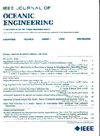气动驱动翼帆设计优化的几何规划
IF 5.3
2区 工程技术
Q1 ENGINEERING, CIVIL
引用次数: 0
摘要
在本文中,我们描述了气动驱动翼帆概念级设计的确定性优化框架。高性能帆船的主要目标是:最大限度地将非定常气动力转化为向前推力,同时不产生过大的倾覆力矩。然而,由于存在多个递归的非线性设计关系,设计一个帆来满足这一目标绝非易事。因此,大多数翼帆都是以迭代的方式设计的,使用线性启发式和工程直觉的某种组合。这种方法可以产生可行的设计,但它是以时间和资本为代价的,并且对潜在的设计空间提供很少的物理洞察力。通过将翼帆设计问题表述为几何程序,可以快速生成数百个最佳候选设计,评估它们对特定约束和参数的敏感性,并确定帕累托边界的形状。与一般的非线性优化方法不同,几何规划优化计算效率高,不需要初始猜测或超参数调优。也许最重要的是,几何规划中的所有决策变量都是同时确定的,从而消除了对子系统进行迭代分段优化的需要。这些好处是有代价的:所有目标和约束函数都必须被描述为多项式。尽管如此,我们证明了这组有限的功能形式可以充分捕捉翼帆参数之间的关键物理关系,并提供可量化的基于物理的设计指导。本文章由计算机程序翻译,如有差异,请以英文原文为准。
Geometric Programming for Aerodynamically-Actuated Wingsail Design Optimization
In this article, we describe a deterministic optimization framework for the conceptual-stage design of aerodynamically-actuated wingsails. The primary objective of high-performance sailing is well understood: maximize the conversion of unsteady aerodynamic forces into forward thrust, without inducing excessive overturning moments. However, designing a sail to meet this goal is by no means straightforward due to the existence of multiple recursive, nonlinear design relationships. Consequently, most wingsails are designed in an iterative fashion, using some combination of linear heuristics and engineering intuition. This approach can produce viable designs, but it does so at the expense of time and capital, and provides little physical insight into the underlying design space. By formulating the wingsail design problem as a geometric program, it is possible to quickly generate hundreds of optimal candidate designs, assess their sensitivity to specific constraints and parameters, and determine the shape of Pareto frontiers. Unlike general nonlinear optimization methods, geometric programming optimization is computationally efficient, and requires no initial guesses or hyperparameter tuning. Perhaps most importantly, all the decision variables in a geometric program are determined simultaneously, eliminating the need for iterative piecewise optimization of subsystems. These benefits come at a price: all objective and constraint functions must be described as posynomials. Nevertheless, we demonstrate that this restricted set of functional forms can adequately capture the key physical relationships between wingsail parameters, and provide quantifiable physics-based design guidance.
求助全文
通过发布文献求助,成功后即可免费获取论文全文。
去求助
来源期刊

IEEE Journal of Oceanic Engineering
工程技术-工程:大洋
CiteScore
9.60
自引率
12.20%
发文量
86
审稿时长
12 months
期刊介绍:
The IEEE Journal of Oceanic Engineering (ISSN 0364-9059) is the online-only quarterly publication of the IEEE Oceanic Engineering Society (IEEE OES). The scope of the Journal is the field of interest of the IEEE OES, which encompasses all aspects of science, engineering, and technology that address research, development, and operations pertaining to all bodies of water. This includes the creation of new capabilities and technologies from concept design through prototypes, testing, and operational systems to sense, explore, understand, develop, use, and responsibly manage natural resources.
 求助内容:
求助内容: 应助结果提醒方式:
应助结果提醒方式:


